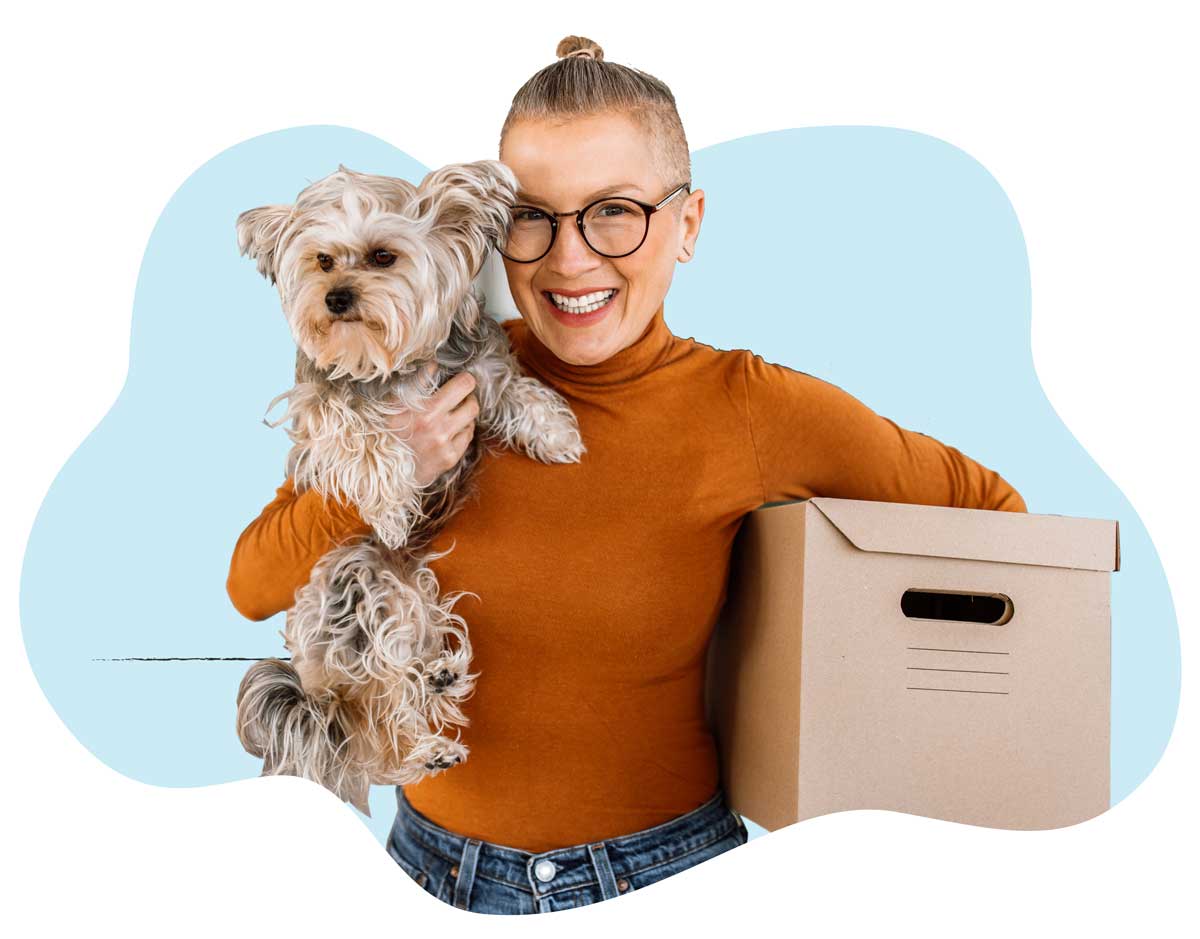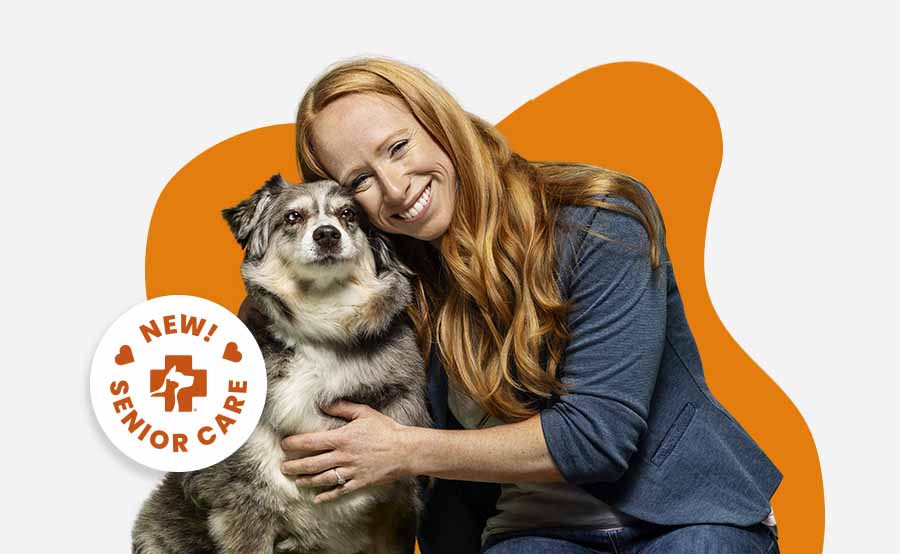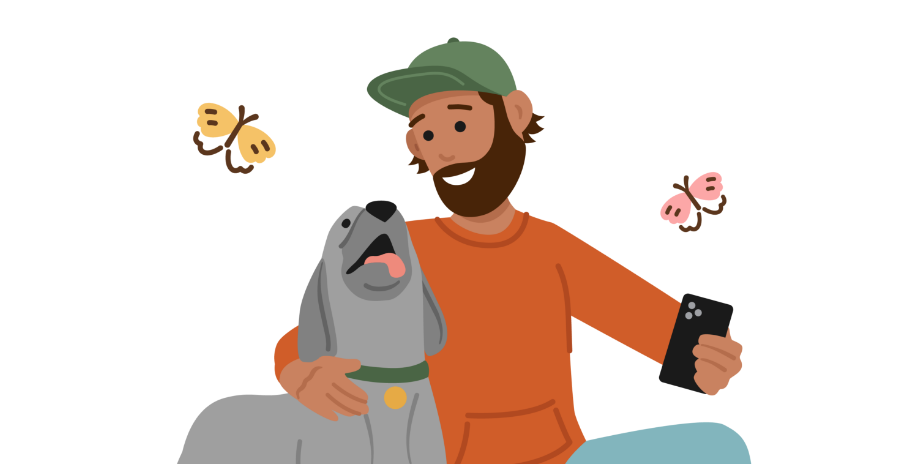exercise and activities for senior dogs and senior cats
Your pet’s getting older, but they likely still need plenty of exercise.
Check out our tips for dog and cat activities to keep your elder pet active.

Best exercises for senior dogs
- Walking
- Swimming
- Playing with toys
- Mobility, strength, and balance exercises

Best exercises for older cats
- Ball and track toys
- Cardboard box “caves”
- Cat trees

Exercise modifications for senior dogs and cats
- Slow down
- Shorten sessions
- Play on carpet versus hard flooring
- Add stairs or ramps to cat trees and furniture
- More mental stimulation versus physical stimulation
Dog activities and cat activities for your senior pets
Staying active is an important part of easing the effects of aging. It can help with muscle tone, joint health, and mental stimulation.

There are also targeted exercises you can do to improve your older cat’s or dog’s strength, balance, and mobility. Talk to your vet if you think your dog or cat could benefit from any of these.
Best exercises for senior dogs for balance and mobility
Balance Exercise: Leg lift and hold
One type of balance exercise you can do with your dog is the “leg lift and hold”.
- Have your dog stand on a nonslip surface. Tap on the leg you want to be lifted and hold out your hand. You might have to help bring the paw up, but do not force this.
- When lifting a front paw with one hand, use your other hand to support the elbow joint of that lifted leg. When lifting a hind paw, support the knee joint of the lifted leg. The goal is for the dog to shift all their weight onto the three legs that remain on the ground while lifting the fourth leg.
- Start by lifting and holding each leg separately for 5-10 seconds. Do a set of 2-3 holds per leg every day or two. This can be increased gradually over time to 20 seconds per leg.
- Reward with praise and/or a food treat.
Mobility Exercise: Cookie stretch
This dog stretch exercise aids with flexibility by utilizing a cookie (not an actual cookie, but a dog-safe food treat) to lure your dog into a position that stretches through their spine. Using a treat to guide your dog’s nose to different parts of the body stretches parts of the neck and spine.
- Have your dog stand comfortably with all four paws on the floor. The front and rear legs should be parallel and stable.
- Lure your dog’s nose:
- Straight up
- Up and to the side
- Toward the chest
- Toward the shoulder
- Toward the elbow
- Toward the front foot
- Toward the hip
- Toward the knee
- Toward the back foot
- Repeat on both sides.
- Your dog should keep a balanced stance with still feet while performing the stretches. If they don’t, shorten the stretch, so they don’t have to reach as far.
- The stretch should last 5-10 seconds in each position and be repeated three times. Depending on your dog’s mobility, you may need to start with fewer positions held for a shorter time and gradually work your way up. These stretches can be done every day.
Strength Exercise: Two paws up
This dog activity is a great way to strengthen your dog’s hind end, a common site of muscle wasting. It involves your dog standing on a slightly elevated object or surface with their two front feet. Set up a platform with a nonslip surface about as high as your dog’s ankles and a few inches wider than your dog’s stance (measuring from the outside of each paw). An aerobic step platform works well for medium or large dogs. A phone book wrapped in duct tape can be used for smaller dogs.
- Start by having your dog slowly step up onto the platform with their front legs only, marking this with a food treat and praise. Then have them slowly step off (again, marking with a treat and praise). Start with 2-3 repetitions. Although this sounds easy, it can be quite a workout for many dogs.
- Once they have the movement down, you can build duration. Initially, hold for about 10 seconds per repetition, three repetitions per set. Increase the duration by five seconds weekly until your dog can do 30 seconds per repetition. This not only helps with strength but also balance.
- When your dog can easily do 30 seconds daily for a week, the height of the elevated surface can be raised by as much as four to six inches. When raising the platform, reduce the duration. For example, increase the height by two inches and decrease the duration to 10 seconds. Over the coming weeks, build up to 30 seconds. Repeat this each time the elevated surface is raised.
- The goal height for medium and large dogs is about eight inches (the height of a stair step). The goal height might be lower for shorter and smaller dogs and those with physical or medical issues. Discuss this with your veterinarian.
- Pay attention if your dog widens the stance of their rear legs when their paws are up on the elevated surface. The exercise is too difficult for them. Reduce the number of repetitions, the height, and/or the duration of the exercise so they can do it without widening their stance.
How much exercise does a senior dog or cat need?
While 30 minutes a day is a good starting place, your dog or cat’s level of activity really depends on your pet’s individual needs. Some factors include your pet's breed, mobility, and medical history. If there are no recent changes to your pet’s health, you are most likely OK providing the same amount of exercise they received as a mature adult.
Talk to your vet if you have any questions or are looking for a more thorough assessment of your senior pet’s exercise needs.

All about exercise safety for senior dogs and older cats
As our pets get older, they might start showing signs of aging, like decreased stamina, strength, and/or mobility. Pay attention to these signs and talk to your vet before making changes to your pet’s exercise routine.
Exercise modifications for older dogs and cats
To make sure your senior pal feels comfortable exercising, here are some potential changes you can make.
- Slow down. Your pet might not be able to handle the same intensity of exercise as they once could.
- Shorten play sessions. You can enjoy the same activities, just for shorter periods of time — especially if you notice your pet getting tired quickly.
- Play on carpet rather than hard flooring. Carpet is more comfortable for an aging pet if they have stiff joints or other mobility issues.
- Add stairs and ramps up to furniture. This will make it easier for pets to reach their favorite spots and avoid any jumping accidents.
- Shift some play sessions to be more mentally rather than physically stimulating. Puzzle toys can be super beneficial to your pet’s health.
When should you stop walking an old dog?
There’s no one-size-fits-all answer for this. Some dogs can go for walks late into life and others experience health issues that make it tougher or impossible. Senior dogs may also be less tolerant of extreme temperatures, so keep an eye out on especially warm or cold days.
If your dog suddenly shows signs of pain, it’s important to immediately halt walking (or any form of exercise) and speak with your vet.
Be on the lookout for these warning signs
While senior cats and dogs can be just as active as their younger selves, it’s important to make sure you don’t push them. Signs of going too far include excessive panting, shaking legs, reluctance to move, and extreme tiredness after the workout. If you notice any of these signs, pull back and discuss them with your vet.
Medically reviewed by Ari Zabell, DVM and Heidi Cooley, DVM.
Custom care that grows with your pet
You can save more than 30% by bundling your pet’s preventive care with an Optimum Wellness Plan. On top of comprehensive exams, vaccinations, and diagnostic testing, these convenient packages also include unlimited office visits, 24/7 Pet Chat™, discounts on most Banfield products, and more.
Our NEW Senior Care Optimum Wellness Plan includes our most in-depth diagnostic testing yet. This helps us detect changes in organ function and overall physical health, so that we can begin any recommended treatment as soon as possible.

Senior Care
Designed to help detect early signs of age-related illness
This plan combines essential services like vaccinations and exams with in-depth diagnostic testing.
See what’s included in Senior CareSenior Care Plus
Designed to help detect early signs of age-related illness and support additional dental needs
This plan includes all the services in our Senior Care plan plus a dental cleaning.
See what’s included in Senior Care Plus Mites and mange
Mites and mange Podcast - Not Just Fluff
Podcast - Not Just Fluff





